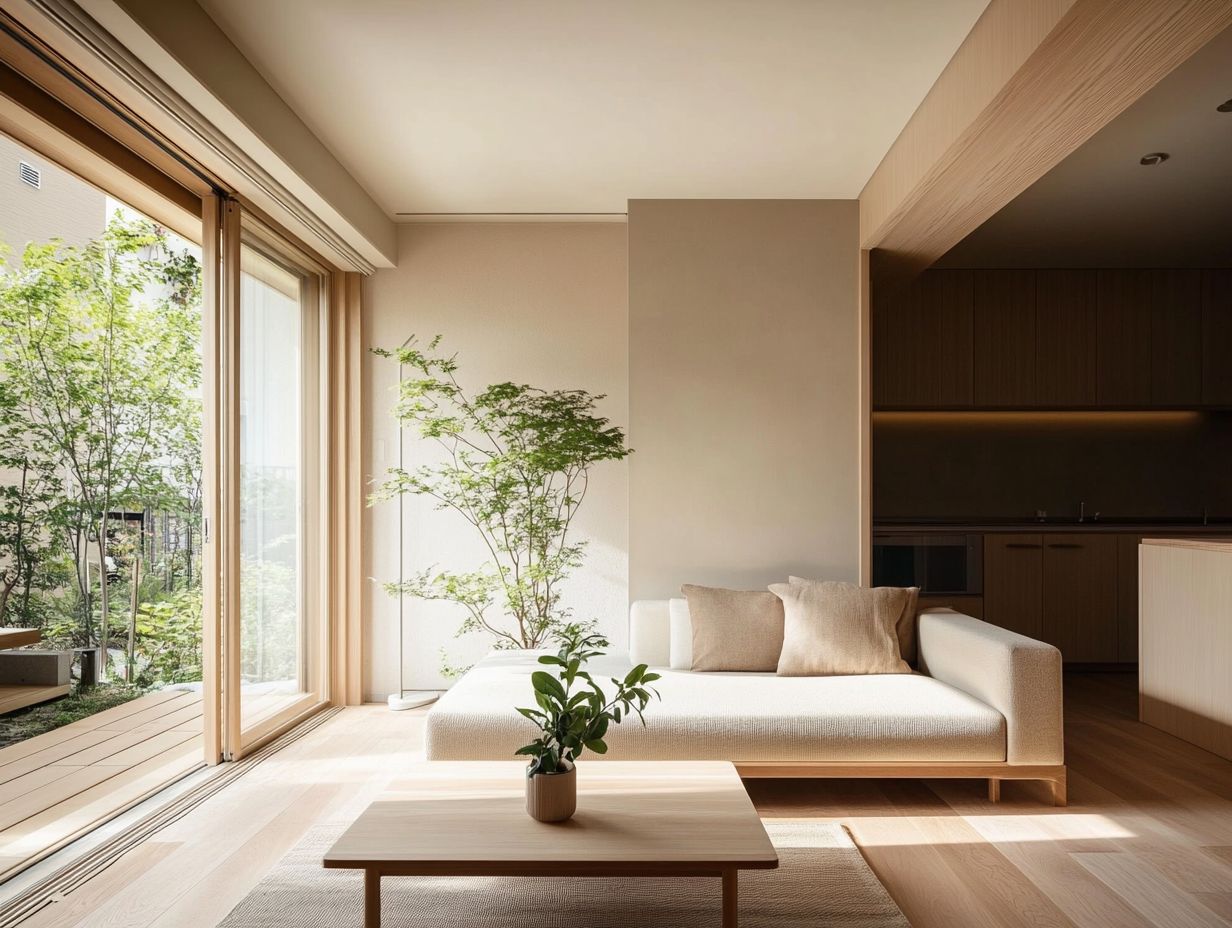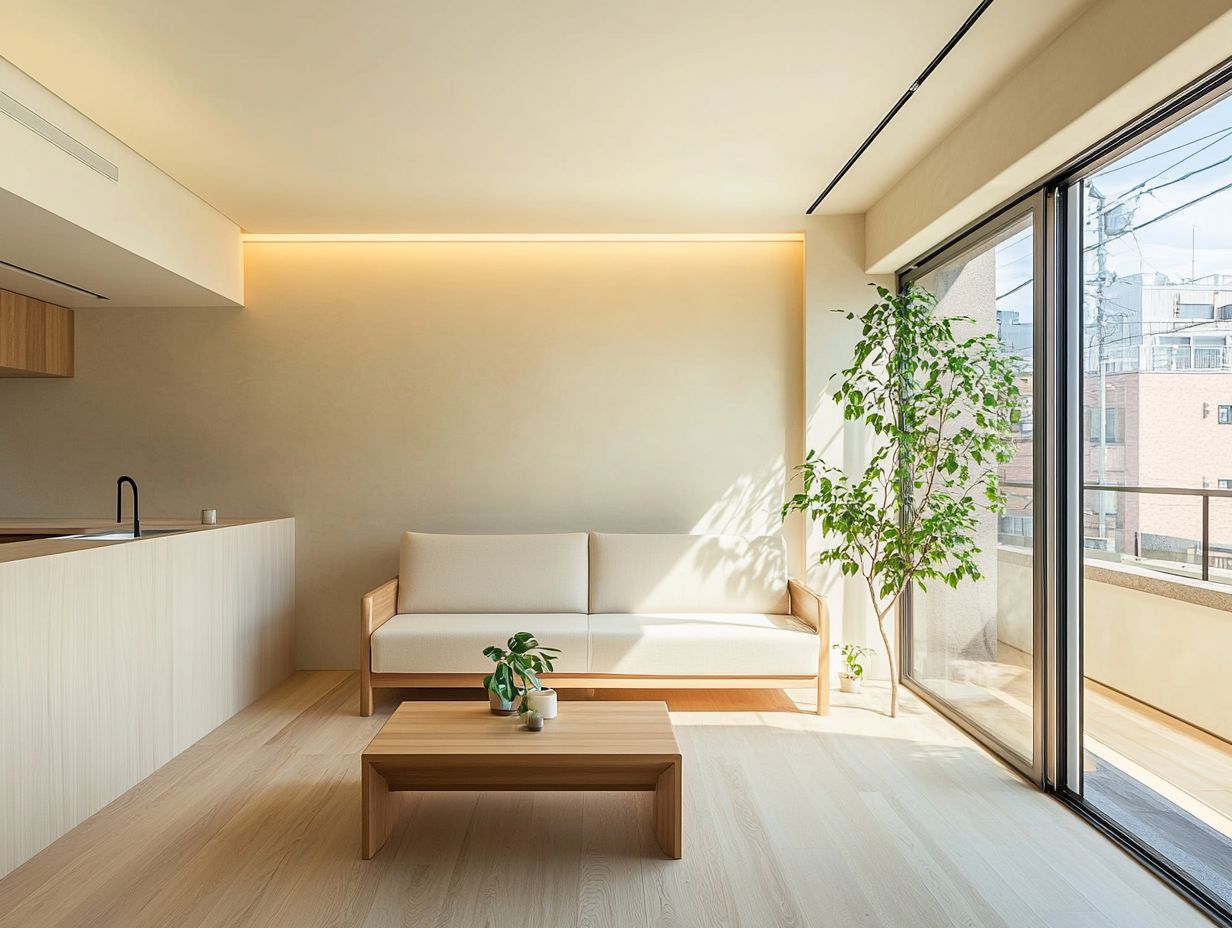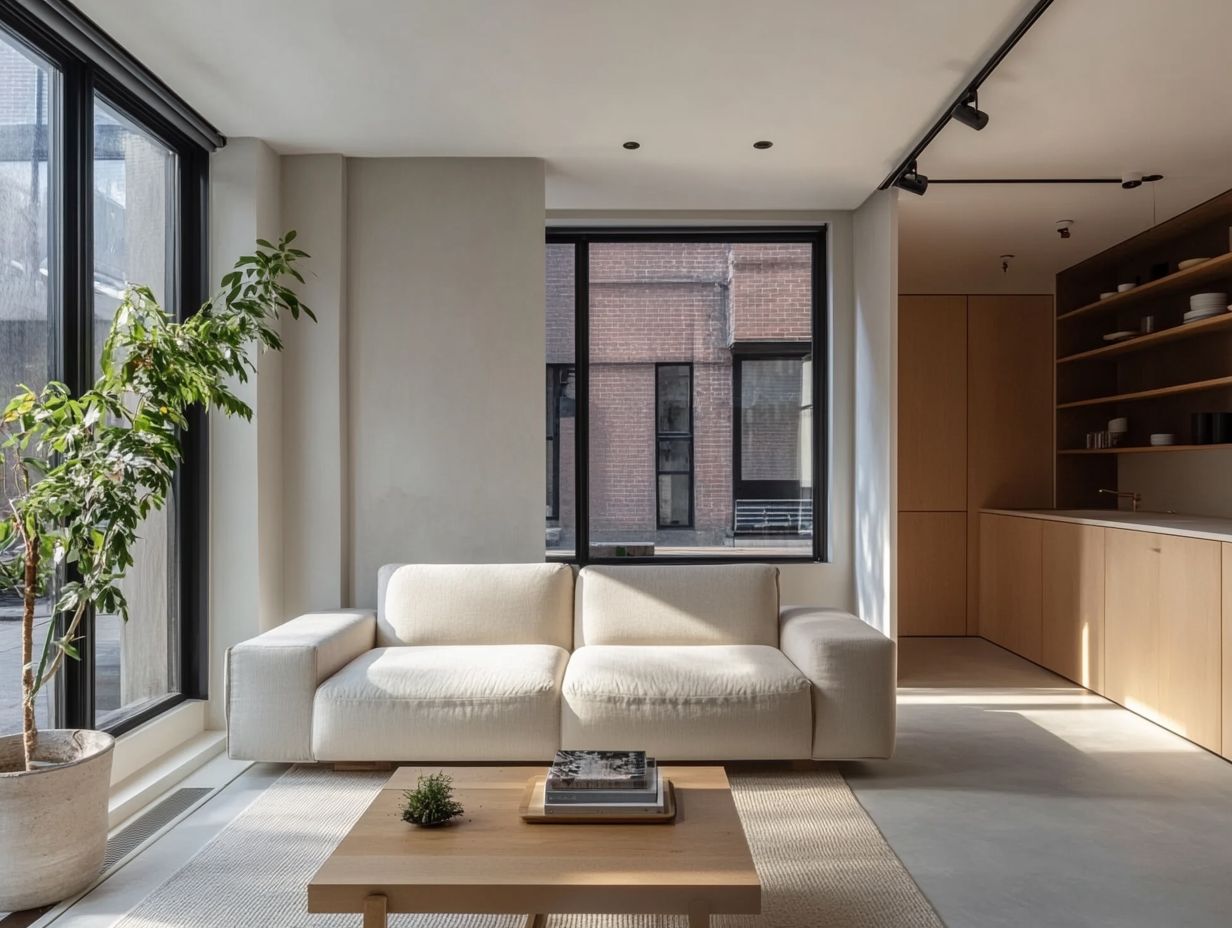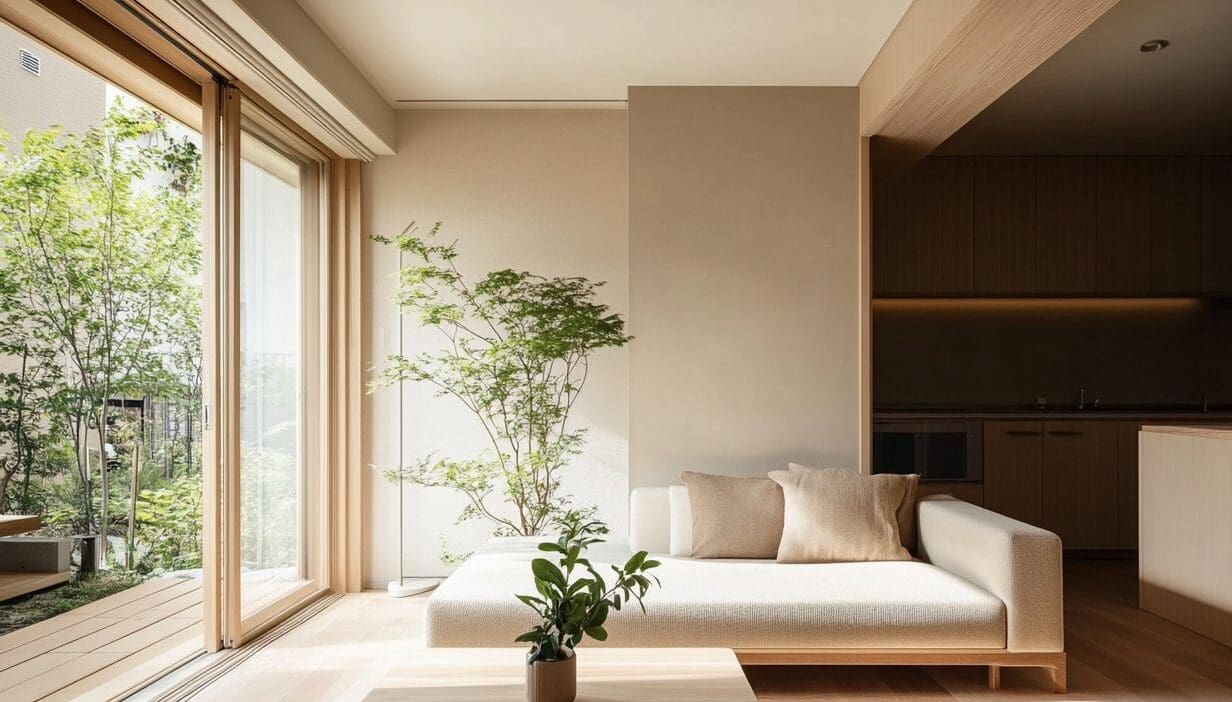In a world characterized by constant distractions and less clutter, the concept of minimalist living provides a refreshing return to simplistic living and tranquility. This article examines the true essence of minimalism, emphasizing its numerous advantages for emotional well-being, health and happiness, and lifestyle efficiency. It offers a structured approach to incorporating this minimalist philosophy into three essential areas of your home: beginning with the bedroom to create a calming environment and peaceful sanctuary, optimizing the kitchen for improved functionality, and transforming the living room into a comfortable, clutter-free space. Explore how adopting minimalism can facilitate a more intentional living and fulfilling life, promoting personal growth and happiness pursuit.
Key Takeaways:
The Concept of Minimalist Living and Home Décor

The concept of minimalist living entails the simplification of one’s life by adopting a lifestyle that emphasizes essential items and the reduction of emotional clutter, ultimately resulting in a liberating way of life.
Minimalism encourages individuals to prioritize quality over quantity, which not only enhances their overall health and happiness but also promotes personal growth through intentional living, a freeing lifestyle, and a mindset shift toward simplicity. According to an insightful examination by BBC Culture, a minimalist life might be the key to happiness by fostering intentionality and reducing the burden of excess.
What is Minimalism?
Minimalism is a lifestyle choice that emphasizes simplicity, focusing on living with fewer possessions and prioritizing meaningful life priorities and experiences over material ownership. This philosophy encourages individuals to declutter their lives, fostering a sense of clarity and purpose.
By adopting minimalist design principles, individuals can create environments that promote tranquility and functionality, often utilizing neutral color palettes and intentional arrangements.
Influencers such as Joshua Becker and Marie Kondo have significantly popularized the minimalist lifestyle, motivating countless individuals to reassess their belongings and make conscious decisions regarding what truly adds value to their lives.
Literature such as “The Life-Changing Magic of Tidying Up”, “The Joy of Less”, and various blogs dedicated to minimalism serve as valuable resources for those seeking inspiration to simplify their surroundings and cultivate a more intentional way of living, promoting sustainable choices and mindful consumption.
Benefits of Minimalist Living and Stress Reduction
The advantages of minimalist living extend beyond mere aesthetic appeal; adopting this lifestyle can result in significant reductions in stress, enhanced emotional well-being, and a more profound pursuit of happiness, thereby promoting both personal growth and family support through minimalist home design.
Recent studies indicate that individuals who embrace minimalism frequently experience lower levels of anxiety and heightened focus, which positively impacts their relationships with family members. Proponents of minimalism, such as Joshua Becker, assert that decluttering physical spaces can facilitate clearer mental spaces, enabling families to communicate more effectively and prioritize quality time together. For those interested in a comprehensive overview, this analysis by Forbes covers the full spectrum of mental health benefits associated with minimalism.
A survey conducted by the Minimalism Project revealed that 96% of participants reported feeling greater satisfaction in their lives after adopting a simpler lifestyle. This finding illustrates that minimalism not only simplifies physical surroundings but also enriches emotional connections, ultimately contributing to a more fulfilling existence.
Starting with the Bedroom and Simple Decorations

Beginning the minimalistic approach with the bedroom is one of the most effective strategies for achieving a minimalist home and incorporating furniture choices, such as modern sofas.
This particular space has the potential to serve as a sanctuary that fosters a calming environment.
By employing decluttering and organization techniques specifically designed for simplicity and tranquility, individuals can create a serene atmosphere conducive to rest and relaxation.
Decluttering and Simplifying with Minimalist Design
Decluttering and simplifying one’s living space is a fundamental practice in adopting a minimalist lifestyle. This approach emphasizes the removal of emotional clutter while retaining only essential items that enhance one’s quality of life.
To embark on this transformative journey, a highly effective method is the Marie Kondo technique, along with living room ideas from influencers like Colin Wright.
This technique encourages individuals to evaluate their possessions based on their emotional impact by asking whether each item sparks joy. According to The Spruce, this process not only facilitates the act of letting go but also fosters mindfulness regarding what truly matters.
For instance, when assessing items in the bedroom, one should consider retaining only essential objects such as:
- a comfortable bed,
- a select few quality garments,
- and cherished books,
as these elements significantly contribute to relaxation and rejuvenation.
By recognizing emotional attachments, individuals can achieve clarity in their decisions regarding what to keep or release, ultimately fostering a serene and clutter-free environment.
Tips for Creating a Peaceful Space with Neutral Color Palette
Creating a tranquil environment in the bedroom necessitates deliberate design choices that emphasize a calming atmosphere. This involves incorporating minimalist design principles and understated decorations that foster relaxation and tranquility.
By thoughtfully selecting a neutral color palette, one can cultivate a sense of serenity throughout the room.
Soft, muted tones such as pale blues, gentle greens, and warm beiges are particularly effective, as they evoke calmness while providing a soothing backdrop for various decorative elements.
Choosing furniture that is both functional and aesthetically pleasing can further enhance this serene atmosphere. It is advisable to consider pieces with clean lines and natural materials, such as a simple wooden bed frame or a sleek bedside table.
Incorporating carefully selected decor items, such as textured throws or minimalistic artwork, can enrich the visual appeal of the space without overwhelming the senses, thereby reinforcing a tranquil sanctuary that is conducive to rest.
Applying Minimalism to the Kitchen and Home Essentials

Implementing minimalism in the kitchen entails the careful selection and organization of essential items while promoting mindful consumption.
This approach ultimately transforms the space into a functional and aesthetically pleasing environment that aligns with a minimalist lifestyle and supports lifestyle changes.
Streamlining Your Kitchen Essentials and Essential Items
Streamlining kitchen essentials is essential for creating a minimalist home, as it promotes the use of only necessary items while incorporating multi-functional furniture to optimize both space and utility.
By thoughtfully selecting versatile tools and appliances, one can significantly enhance the cooking experience without overcrowding the kitchen. When determining which items to retain, it is advisable to consider products that serve multiple purposes, such as a food processor that can chop, blend, and slice, thus eliminating the need for separate devices.
This approach not only simplifies the kitchen environment but also fosters efficiency during meal preparation, allowing for more accessible tools that perform various functions.
Reducing clutter contributes to a more organized atmosphere, enabling individuals to concentrate on creativity and find joy in their culinary endeavors.
Organizing for Efficiency with Organization Tips
Organizing the kitchen for efficiency is essential in a minimalist lifestyle, as it ensures that every essential item has a designated space and is easily accessible. This arrangement ultimately facilitates smoother meal preparation and supports lifestyle changes.
To achieve this goal, individuals can explore various organization strategies that eliminate clutter and promote functionality.
- Incorporating drawer organizers can effectively categorize utensils and tools, allowing for the easy retrieval of specific items without the need to sift through an overcrowded drawer.
- Additionally, implementing a labeling system on storage containers can streamline the cooking process by providing immediate visibility into pantry supplies and ingredients.
Thoughtful spatial planning, which takes into account the flow of movement within the kitchen, can significantly reduce the time spent retrieving items or preparing meals.
These strategies not only adhere to the principles of minimalism but also contribute to a more enjoyable and stress-free cooking experience, supporting time management and sustainable choices.
Transforming the Living Room with Minimalist Design

Transforming the living room into a minimalist space entails the implementation of practical design concepts that emphasize the use of clear surfaces and the reduction of visual distractions.
This approach results in a serene environment that fosters relaxation and facilitates social interaction.
Eliminating Excess and Creating a Cozy Space with Visual Appeal
Eliminating excess in the living room is essential to creating a cozy environment that embodies the principles of minimalism, where carefully selected accent pieces enhance comfort without overwhelming the senses.
To achieve this balance, individuals should first evaluate their current belongings, identifying items that no longer serve a purpose or evoke joy, with guidance from the Minimalism Project and influencers like Leo Babauta.
It may be advisable to remove bulky furniture in favor of streamlined alternatives that provide functionality while maintaining an airy ambiance.
When selecting accent pieces, such as cushions or minimalist artwork, it is important to prioritize neutral colors and simple designs that complement the overall aesthetic. Incorporating natural textures, such as wood or woven materials, can contribute warmth without introducing clutter, a principle common in Japanese homes.
By embracing open spaces and thoughtfully curated decor, one can create an inviting atmosphere that reflects both style and tranquility, ultimately enhancing personal satisfaction.
Incorporating Minimalist Design Principles
Incorporating minimalist design principles into a living room can significantly enhance its visual appeal and contribute to emotional well-being, particularly through the careful selection of modern sofas and coffee tables that align with minimalist aesthetics. This method is often recommended by experts like Joshua Fields Millburn and Ryan Nicodemus, co-founders of The Minimalists.
This approach emphasizes the elimination of clutter and distractions, thereby fostering a serene environment where each piece of furniture serves a distinct purpose, which is a key aspect of the simplicity mindset.
When selecting furniture, it is advisable to choose streamlined designs in neutral colors, such as a sleek, low-profile sofa complemented by soft, textured throw pillows. Featuring family photos alongside these selections can add a personal touch. This can be paired with a slender coffee table crafted from glass or light wood to maintain a sense of openness, reflecting the benefits of minimalism in home decor.
Additionally, integrating thoughtfully selected decor items, such as a single modern art piece or a simple ceramic vase, will ensure that each element not only complements the overall design but also evokes a sense of calm and tranquility. This design approach can also support a social media detox by creating a peaceful environment.



